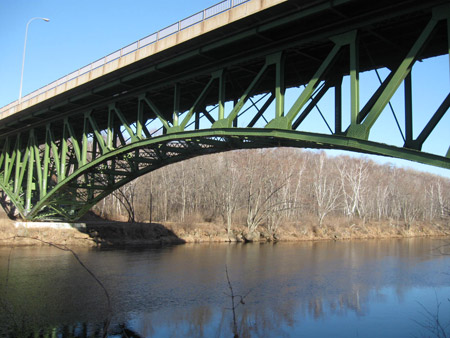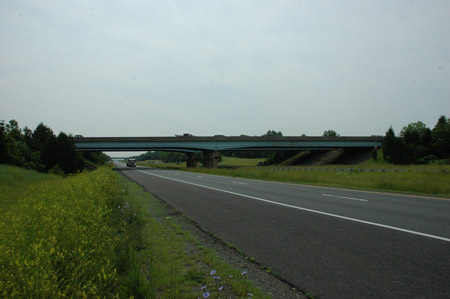U.S. Department of Transportation
Federal Highway Administration
1200 New Jersey Avenue, SE
Washington, DC 20590
202-366-4000
Focus
| Accelerating Infrastructure Innovations |
Publication Number: FHWA-HRT-12-017
Date: September 2012
Printable Version (.pdf, 0.3 mb)
The Federal Highway Administration (FHWA) Long-Term Bridge Performance (LTBP) program continues to move forward in advancing knowledge of bridge performance.
Many factors influence the condition and performance of bridges. Structures differ greatly by span type, design features, construction materials, dimensions, live load histories, environmental and climatic factors, and physical changes that occur on the bridge. A bridge's history of maintenance, preservation, and rehabilitation is also a variable that influences long-term performance.
Launched in 2008, the LTBP program will capture and document the performance of a representative sample of bridges nationwide. This effort will encompass detailed inspection, periodic monitoring, evaluation and testing, and possible forensic investigation. The bridges will feature several representative structural types and materials, as well as variations in geometry, age, traffic volume, truck loads, and climatic conditions.
Ultimately this comprehensive study will result in a high-quality body of data and knowledge, leading to the development of improved life-cycle cost and deterioration models, better understanding of bridge deterioration, and improved effectiveness of maintenance and repair strategies. The data will also support improved design methods and bridge preservation practices, as well as facilitate the development of the next generation of bridges and bridge management tools.

Pilot bridges for the Long-Term Bridge Performance (LTBP) program included this steel deck truss bridge in Sandstone, MN.
In 2009, the program began a pilot study to validate protocols for data collection and management and obtain a baseline understanding of bridge deck performance and deterioration. "This initial effort was intended to ensure that all of the components needed to achieve the long-term objectives of the LTBP program were well defined before initiating work on a large population of bridges nationwide," said Hamid Ghasemi, Manager of the LTBP program at FHWA.
Seven bridges in California, Florida, Minnesota, New Jersey, New York, Utah, and Virginia were studied, providing a broad representation of environmental conditions experienced throughout the United States. "Execution of the pilot phase was quite complex and provided many lessons learned, resulting in FHWA reexamining the methods for field work, particularly with respect to coordination between field personnel and State highway agencies," said Ghasemi. "Protocols have now been developed to ensure that the program collects early and useful quality data." The protocols are not standards but rather a guide to refine and streamline testing methodologies.
Protocols include:
The program's long-term data collection phase is scheduled to begin in November 2012. This first phase will focus on steel stringer and prestressed concrete multi-girder bridges in the Mid-Atlantic region, with potentially 75 bridges tested.
More information on the LTBP program will be available in a collection of reports and technical briefs to be released by spring 2013. These publications will include a summary of the program's pilot phase, as well as individual reports on each bridge included in the pilot phase. Also being developed are a Bridge Performance Primer and reports on Protocols for Data Collection, High-Priority Bridge Performance Issues, and Identifying Bridge Data Needs.
One product under development is the Bridge Portal, a Web-based centralized data storage and retrieval application. This application will incorporate in one location not only legacy bridge data but also traffic, weather, seismic, maintenance, and preservation data, as well as data collected from LTBP bridge sites. The Bridge Portal will also incorporate data-driven life cycle and deterioration models, which will allow users to investigate bridge performance holistically.
As the LTBP program moves into the data collection phase, FHWA continues to reach out to stakeholders to seek input on the design and direction of the program. The Transportation Research Board provides guidance through its LTBP Advisory Committee, as well as input on specific research areas through its Durability and Preservation, Evaluation and Monitoring, and Traffic and Truck Weights Expert Task Groups.
FHWA held focus group meetings with the bridge offices of 15 State transportation departments to discuss the program's objectives and needs. FHWA also established the LTBP State Coordinators Committee, which includes a representative from transportation agencies in each State; Washington, D.C.; and Puerto Rico. "The input from the State coordinators has already been influential in the program's technical coordination and implementation," said Ghasemi.
Participation by the bridge engineering community is also very important to the success of the program. FHWA issued a Request for Information earlier this year for industry organizations to discuss ways that they could collaborate with the LTBP program. A public meeting was then held in July 2012 that included representatives from manufacturing and trade organizations, consultants, contractors, and academia. Future involvement with selected organizations may include sharing of bridge data or contributions of products, services, or expertise that support the LTBP program.
For more information on the LTBP program, visit www.fhwa.dot.gov/research/tfhrc/programs/infrastructure/structures/ltbp, or contact Hamid Ghasemi at FHWA, 202-493-3024 (email: ltbp@dot.gov).

Also studied in the LTBP program's pilot phase was this continuous steel stringer bridge in Prince William County, VA.